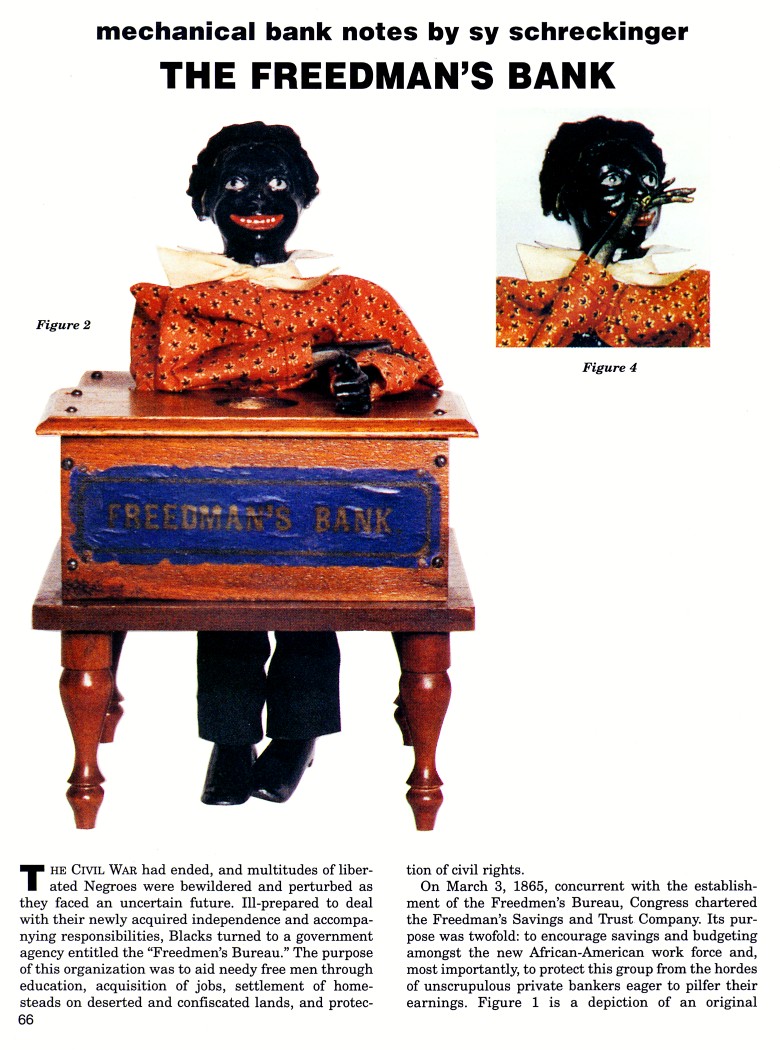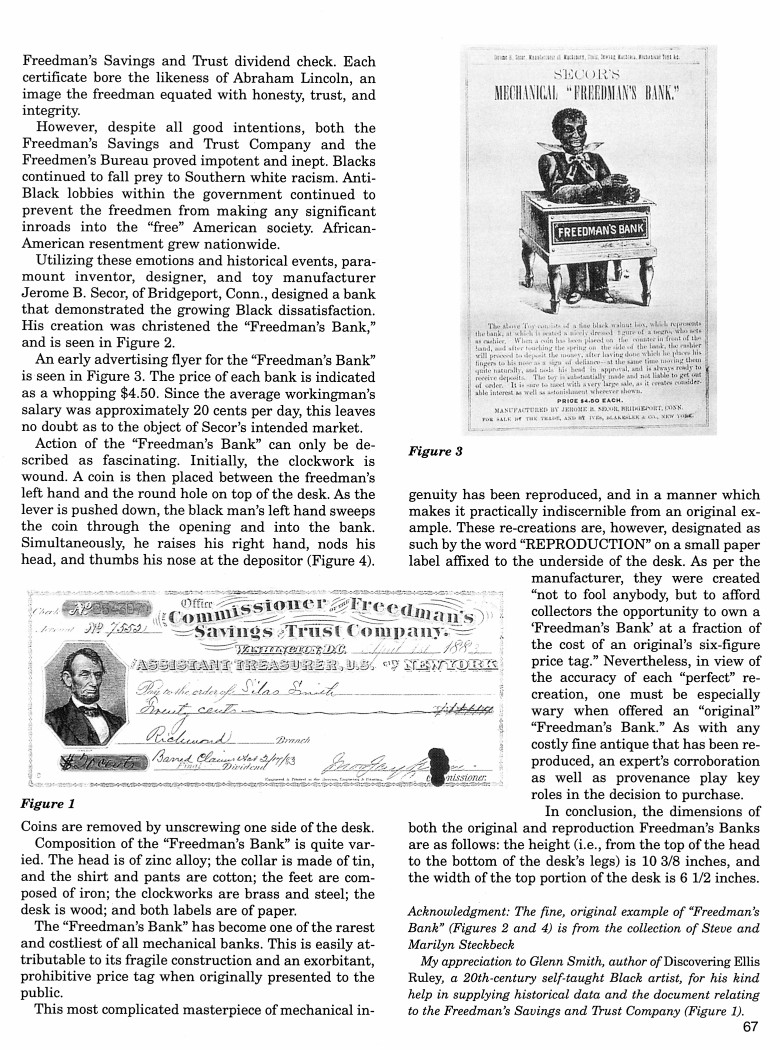|
The Freedman’s Bank
by Sy Schreckinger – ANTIQUE TOY WORLD Magazine – July, 1997
The Civil War had ended, and multitudes of
liberated Negroes were bewildered and perturbed as they faced an uncertain
future. Ill-prepared to deal with their newly acquired independence and
accompanying responsibilities, Blacks turned to a government agency
entitled the "Freedmen's Bureau." The purpose of this organization was to
aid needy free men through education, acquisition of jobs, settlement of
homesteads on deserted and confiscated lands, and protection of civil
rights.
On March 3, 1865, concurrent with the establishment of the Freedmen's
Bureau, Congress chartered the Freedman's Savings and Trust Company. Its
purpose was twofold: to encourage savings and budgeting amongst the new
African-American work force and, most importantly, to protect this group
from the hordes of unscrupulous private bankers eager to pilfer their
earnings. Figure 1 is a depiction of an original Freedman's Savings and
Trust dividend check. Each certificate bore the likeness of Abraham
Lincoln, an image the freedman equated with honesty, trust, and integrity.
However, despite all good intentions, both the Freedman's Savings and
Trust Company and the Freedmen's Bureau proved impotent and inept. Blacks
continued to fall prey to Southern white racism. Anti-Black lobbies
within the government continued to prevent the freedmen from making any
significant inroads into the "free" American society. African-American
resentment grew nationwide.
Utilizing these emotions and historical events, paramount inventor,
designer, and toy manufacturer Jerome B. Secor, of Bridgeport, Conn.,
designed a bank that demonstrated the growing Black dissatisfaction. His
creation was christened the "Freedman's Bank," and is seen in Figure 2.
An early advertising flyer for the "Freedman's Bank" is seen in
Figure 3. The price of each bank is indicated as a whopping $4.50. Since
the average workingman's salary was approximately 20 cents per day, this
leaves no doubt as to the object of Secor's intended market.
Action of the "Freedman's Bank" can only be described as fascinating.
Initially, the clockwork is wound. A coin is then placed between the
freedman's left hand and the round hole on top of the desk. As the lever
is pushed down, the black man's left hand sweeps the coin through the
opening and into the bank. Simultaneously, he raises his right hand, nods
his head, and thumbs his nose at the depositor (Figure 4). Coins are
removed by unscrewing one side of the desk.
Composition of the "Freedman's Bank" is quite varied. The head is of
zinc alloy; the collar is made of tin, and the shirt and pants are cotton;
the feet are composed of iron; the clockworks are brass and steel; the
desk is wood; and both labels are of paper.
The "Freedman's Bank" has become one of the rarest and costliest of
all mechanical banks. This is easily attributable to its fragile
construction and an exorbitant, prohibitive price tag when originally
presented to the public.
This most complicated masterpiece of mechanical ingenuity has been
reproduced, and in a manner which makes it practically indiscernible from
an original example. These re-creations are, however, designated as such
by the word "REPRODUCTION" on a small paper label affixed to the underside
of the desk. As per the manufacturer, they were created "not to fool
anybody, but to afford collectors the opportunity to own a 'Freedman's
Bank' at a fraction of the cost of an original's six-figure price tag."
Nevertheless, in view of the accuracy of each "perfect" recreation, one
must be especially wary when offered an "original" "Freedman's Bank." As
with any costly fine antique that has been reproduced, an expert's
corroboration as well as provenance play key roles in the decision to
purchase.
In conclusion, the dimensions of both the original and reproduction
Freedman's Banks are as follows: the height (i.e., from the top of the
head to the bottom of the desk's legs) is 10-3/8 inches, and the width of
the top portion of the desk is 6-1/2 inches.
Acknowledgment: The fine, original example of "Freedman's Bank"
(Figures 2 and 4) is from the collection of Steve and Marilyn Steckbeck.
My appreciation to Glenn Smith, author of Discovering Ellis Ruley, a
20th-century self-taught Black artist, for his kind help in supplying
historical data and the document relating to the Freedman's Savings and
Trust Company (Figure 1).
|


